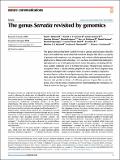Files in this item
The genus Serratia revisited by genomics
Item metadata
| dc.contributor.author | Williams, David J. | |
| dc.contributor.author | Grimont, Patrick A. D. | |
| dc.contributor.author | Cazares, Adrián | |
| dc.contributor.author | Grimont, Francine | |
| dc.contributor.author | Ageron, Elisabeth | |
| dc.contributor.author | Pettigrew, Kerry A. | |
| dc.contributor.author | Cazares, Daniel | |
| dc.contributor.author | Njamkepo, Elisabeth | |
| dc.contributor.author | Weill, François-Xavier | |
| dc.contributor.author | Heinz, Eva | |
| dc.contributor.author | Holden, Matthew T. G. | |
| dc.contributor.author | Thomson, Nicholas R. | |
| dc.contributor.author | Coulthurst, Sarah J. | |
| dc.date.accessioned | 2022-09-05T10:30:24Z | |
| dc.date.available | 2022-09-05T10:30:24Z | |
| dc.date.issued | 2022-09-03 | |
| dc.identifier | 281180256 | |
| dc.identifier | df5d91ee-48f5-4f2b-8c1f-f1bb8ce63353 | |
| dc.identifier | 85137169808 | |
| dc.identifier | 000849494300020 | |
| dc.identifier.citation | Williams , D J , Grimont , P A D , Cazares , A , Grimont , F , Ageron , E , Pettigrew , K A , Cazares , D , Njamkepo , E , Weill , F-X , Heinz , E , Holden , M T G , Thomson , N R & Coulthurst , S J 2022 , ' The genus Serratia revisited by genomics ' , Nature Communications , vol. 13 , 5195 . https://doi.org/10.1038/s41467-022-32929-2 | en |
| dc.identifier.issn | 2041-1723 | |
| dc.identifier.other | Jisc: 582055 | |
| dc.identifier.other | publisher-id: s41467-022-32929-2 | |
| dc.identifier.other | manuscript: 32929 | |
| dc.identifier.other | ORCID: /0000-0002-4958-2166/work/118800384 | |
| dc.identifier.uri | https://hdl.handle.net/10023/25945 | |
| dc.description | This work was supported by Wellcome (grant numbers: 104556, Senior Research Fellowship S.J.C.; 220321, Senior Research Fellowship Renewal S.J.C.; 109118, Ph.D. studentship; 206194, N.R.T.), the NIHR (NIHR200639, AMR Capital Award to University of Dundee), and Institut Pasteur and INSERM (P.A.D.G. and F.X.W.). | en |
| dc.description.abstract | The genus Serratia has been studied for over a century and includes clinically-important and diverse environmental members. Despite this, there is a paucity of genomic information across the genus and a robust whole genome-based phylogenetic framework is lacking. Here, we have assembled and analysed a representative set of 664 genomes from across the genus, including 215 historic isolates originally used in defining the genus. Phylogenomic analysis of the genus reveals a clearly-defined population structure which displays deep divisions and aligns with ecological niche, as well as striking congruence between historical biochemical phenotyping data and contemporary genomics data. We highlight the genomic, phenotypic and plasmid diversity of Serratia, and provide evidence of different patterns of gene flow across the genus. Our work provides a framework for understanding the emergence of clinical and other lineages of Serratia. | |
| dc.format.extent | 18 | |
| dc.format.extent | 2974338 | |
| dc.language.iso | eng | |
| dc.relation.ispartof | Nature Communications | en |
| dc.subject | QR Microbiology | en |
| dc.subject | QH426 Genetics | en |
| dc.subject | DAS | en |
| dc.subject.lcc | QR | en |
| dc.subject.lcc | QH426 | en |
| dc.title | The genus Serratia revisited by genomics | en |
| dc.type | Journal article | en |
| dc.contributor.institution | University of St Andrews. School of Medicine | en |
| dc.contributor.institution | University of St Andrews. Biomedical Sciences Research Complex | en |
| dc.contributor.institution | University of St Andrews. St Andrews Bioinformatics Unit | en |
| dc.contributor.institution | University of St Andrews. Infection and Global Health Division | en |
| dc.identifier.doi | 10.1038/s41467-022-32929-2 | |
| dc.description.status | Peer reviewed | en |
This item appears in the following Collection(s)
Items in the St Andrews Research Repository are protected by copyright, with all rights reserved, unless otherwise indicated.

